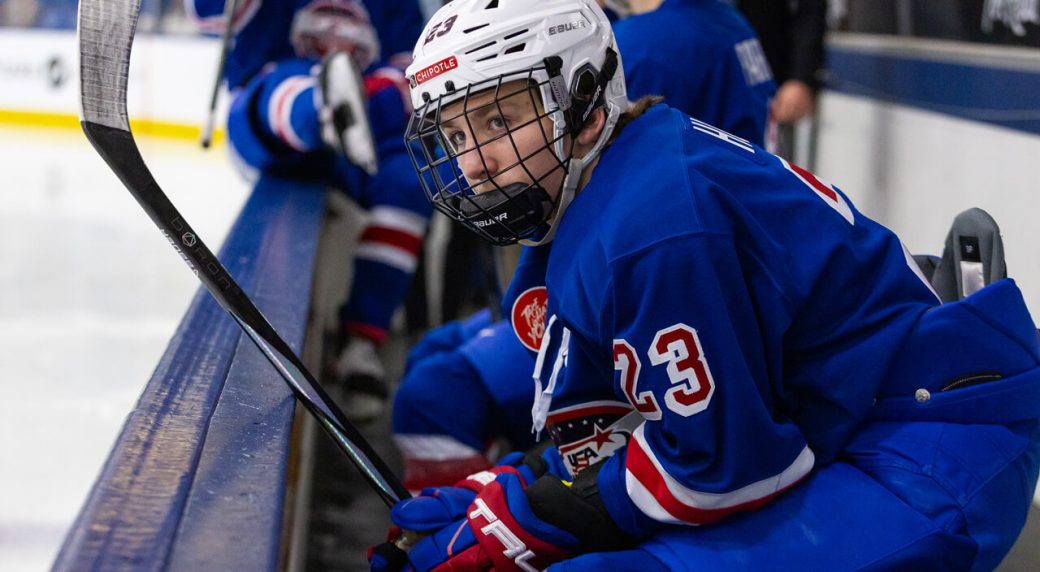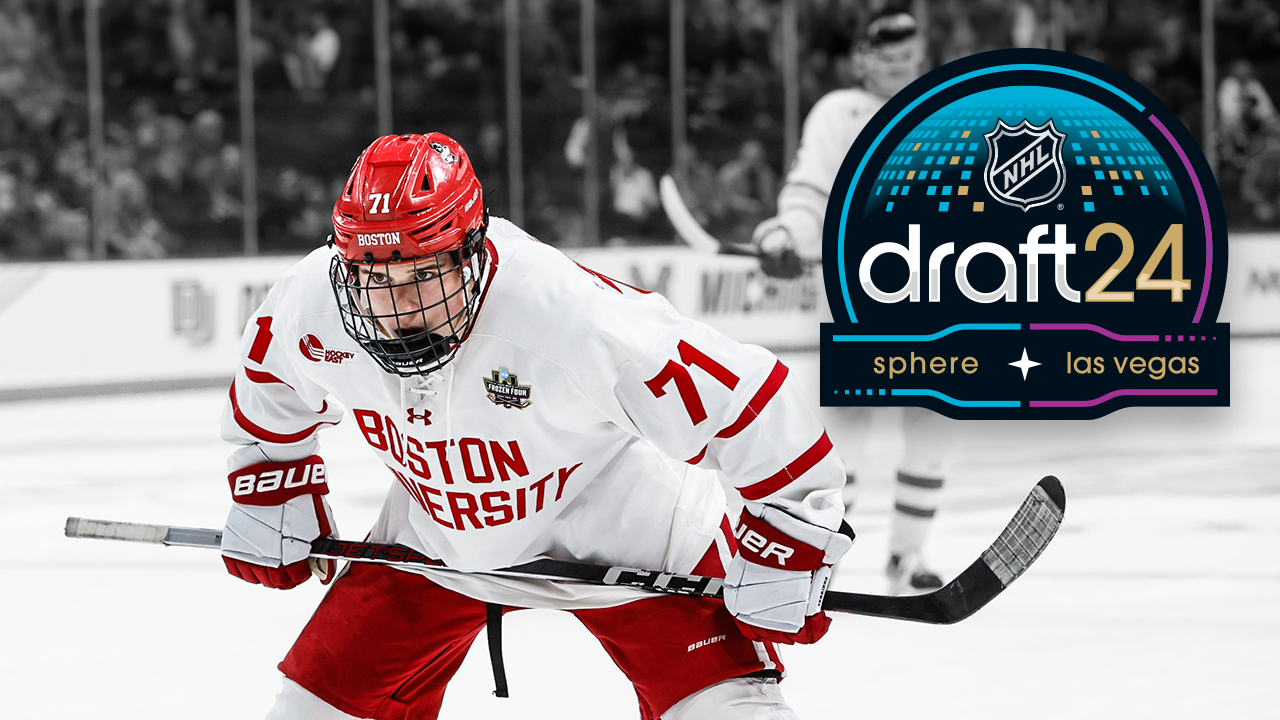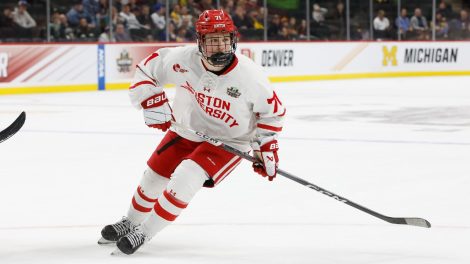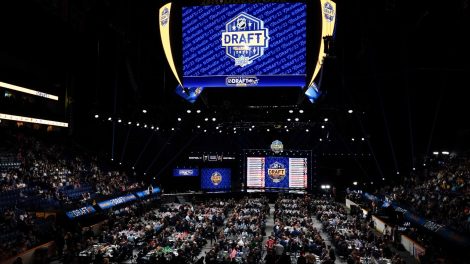Cole Hutson isn’t the kind of prospect you have to watch a lot to appreciate. The defenceman for the U.S. National Team Development Program has a toolkit that jumps off the sheet, with his shake-you-off jukes and divebombs into the zone from the offensive blueline. Moreover, the kid who turns 18 on Day 1 of the 2024 NHL Draft already has multiple sparkling international showings on his resume from the past couple of seasons.
Still, those who see Hutson all the time believe if you’re not truly watching him game after game, you might be missing just how often he rises to the occasion. It’s not just when there’s a medal on the line in Europe that Hutson’s inherent understanding of when to step up kicks in, it’s also weeknights in the American Midwest. It could be a situation where his team coughs up a lead and needs to get back on track. Or it could be a scenario like the one that played out in Grand Forks, North Dakota, in late December. The NTDP squad was getting swarmed by the NCAA’s North Dakota Fighting Hawks, but goalie Nick Kempf made 36 saves to get them to overtime. That’s when No. 23 in blue took over the three-on-three action and buried a winner past Hawks tender Hobie Hedquist.
“He was not going to be denied,” says NTDP bench boss Nick Fohr of that night. “We had no business winning that hockey game, our goalie stole it, but we don’t win that game without [Hutson] in that moment, when he got that puck to score that goal. He has that piece to him that a lot of [other players] don’t have.”
Hutson is the third of four hockey-playing brothers, all born between 2002 and 2008. Lane, two years Cole’s senior, has justified the Canadiens’ decision to select him with pick No. 62 in the 2022 draft by becoming one of the top prospects in Montreal’s system. Now comes Cole. While the younger Hutson surely faces fewer size-related questions than his brother, this is still very much a case where if he was six-foot-one, we’d be talking about him as a surefire top-10 pick instead of someone who could conceivably slide to the bottom of the first round. Wherever he’s selected, though, Hutson will follow the footsteps of Lane and his oldest brother, Quinn, to powerhouse Boston University next year, and it sure feels like, with a couple of years to refine his game and strengthen his body at college, he could become every bit the high-end prospect Lane already is.
Huston doesn’t try to distance himself from comparisons to Lane. He’s acknowledged in the past they both developed a chip on their shoulder thanks to constant chatter about their stature and you get the sense they’ve linked arms and are out to prove they both can be fantastic NHLers. While the typical sibling rivalry stuff is there — you’d expect nothing less with elite-athlete brothers — it’s clear Hutson holds Lane in high regard. “When you’re out there with just Lane or a few other guys, it’s something you don’t take for granted,” he said at the NHL Draft Scouting Combine in early June, referring to off-season skating sessions. “When you’re watching their reps and watching what they’re so good at, you can take little things they’ve mastered and try to emulate it. It’s a pleasure skating with Lane all the time. I learn so much from him and I’ll continue to.”
If there’s a Hutson 2.0 dynamic here, it’s that Cole — at five-foot-10 and 165 pounds — is a couple of inches taller and roughly 15 pounds heavier than Lane was at the same stage. (The older Hutson has grown to hit that five-foot-10 mark now). That, combined with the fact it’s more and more common for undersized blue-liners to have a major impact on today’s NHL games, means there’s a little less bias working against Cole.
Fohr has seen not only physical growth from Hutson at the NTDP, but much in the way of maturation on the ice, too. When the go-for-it gene accounts for a huge part of your makeup, the risk-reward conversation is sure to follow. “He’s magic with the puck on his stick and he brings people out of their seat, very much like his brother,” Fohr says. “But he’s learned to manage his decisions. When he first came to play for us, there was not a play on the rink he didn’t think he could make, no matter what was in front of him. He really learned through two years how to make decisions.”
Fohr’s job is to shape these players in order to give them the best chance of success at higher levels. In Hutson’s case, that meant logging time in the film room dissecting all kinds of on-ice situations. “It was a two-year process and there were plenty of video sessions and meetings [with us asking], ‘What was going through your mind here?’ and ‘What do you see on the ice, why did you make the decision you made?’” Fohr says. “It takes time to make those reads. He’s still not perfect with it, but he’s come a really long ways and he’s receptive to [coaching and feedback].”
Naturally, a big focus of development with the NTDP was on the defensive side of the puck. Small guys can chafe all they want at the size queries, but there remain certain realities to a still-physical sport that put them at a disadvantage. Increasingly, Hutson is figuring out what the workarounds are and how to minimize the fact he’s often in a spot where he’s got to directly engage a guy with a much larger frame.
“He’s just smart with how he does things,” Fohr says. “He understands that if the puck is chipped into his corner and he’s in a foot race with a guy who is [six-foot-three and 195 pounds], if he gets to that puck first, he’s probably not coming out of there with it. So, he’s learned how to allow the other team to get the puck, then close that [gap] out as that guy is getting the puck. If he’s got that forechecker on the wall, as opposed to him being on the wall, now he’s got outs. I think he got really good at using his position and skill and his talent to be able to close those plays out and be able to get pucks out of those areas and understand that, as an undersized guy, he can’t get that puck because he can’t do anything with it if he does.
“Learning how to do that, that’s a skill in itself.”
When you consider the strides Hutson has taken in his own end, the whole enchilada gets tantalizing fast, especially given his ability to be an O-zone maestro. This is a defenceman who jumped up at last year’s IIHF U18 World Championship to play with and against kids who were nearly all a year older than him, and wound up winning gold with Team USA while making the tournament all-star team and leading the event in points by a D-man, with 12 in seven outings. “He’s a stud,” says Zeev Buium, a defenceman on that American squad and top prospect for the 2024 draft. “I learned a lot watching him at the blue line. He’s pretty shifty. It was awesome to see what he can do and obviously his brother, Lane, too, they’re both unbelievably gifted offensively. If I could take something from [Cole], it would be some of the head fakes he can do on the blue line.”
Hutson’s return to the U18 worlds was no certainty in late April because of a high-ankle sprain that plagued him leading up the event in Finland. Not only did he wind up posting for Team USA, he was named best defenceman at the tourney. “He was probably 80 per cent — maybe 85 — on that leg, but that didn’t stop him from being the best defenceman in the tournament,” says Fohr. “He was so good.”
Fohr’s team lost the gold-medal game to Canada despite Hutson notching a goal that put them up 3-1 halfway through the contest. Disappointing as silver was, Hutson’s performance once again underlined why — in a way — he stands a head above so many players.
“The biggest thing is that ‘It’ factor,” Fohr says. “The good players want the puck on their stick in a big moment, and he proved that over two years with us; the bigger the moment, the better he was; the bigger the moment, the more he wanted the puck.”
Guess what he wants next.












